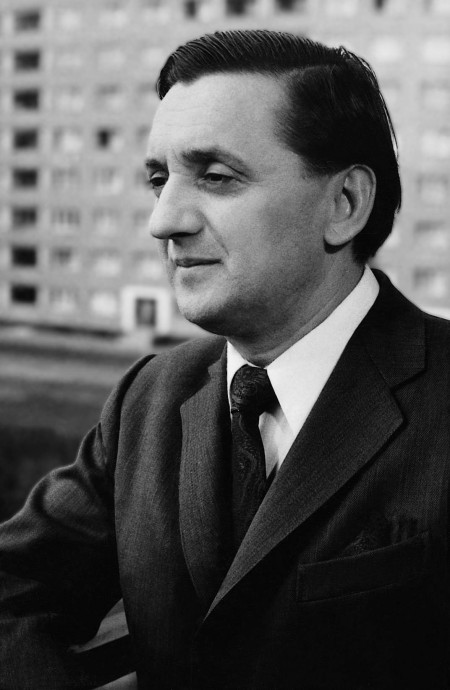30 March 1931, Kunágota - 8 December 2013, Sopron
Sándor Szokolay, composer is a determinative personality of the Hungarian music of the 20th century. His operas should be named as an outstanding field of his life achievement, which mean his career's milestones in his rich compositional output. His theatrical talent and dramatic sense fortunately coupled with his basic need for vocal idiom of expression led him to the world of the theater. The appearance of the latter, following the instrumental works of the first period, was based and prepared during his high-school years: he studied at the Music Liceum in Békéstarhos between 1947 and 1950, which was operating in the spirit of Kodály's pedagogical ideas proving them by bright results (and which was inexcusably soon terminated), and his experiences gained there launched his compositional career.
He was a student of Ferenc Szabó and Ferenc Farkas between 1950 and 1957 at the composition department of the Academy of Music and had been teaching there from 1959 to his retirement in 1994, as a docent from 1966 and later as a professor. Besides that he worked at the Hungarian Radio and Television as a lector and editor and also took public positions at social organizations (Kodály Society, Hungarian Chamber of Music, etc.) He has been living in Sopron from 1994.
The instrumental works from the end of the 1950s are: besides his solo viola sonata, violin- and piano concerto, successful vocal and stage works mark the main grades of the development of his creative work: two oratorios, the Tűz Márciusa [March of the Fire] (1957-58) composed on the revolutionary poems by Ady and the Istár pokoljárása [Ishtar's Journey to the Hell] (1960 on the texts of Sándor Weöres), a ballet, titled Az iszonyat balladája [The Ballad of Loathing] (1960) and the Világok vetélkedése [A Rivalry of Worlds] (1959), the Cantata Nigra (1962) and the Déploration (1964), written in the memory of Poulenc. The closing and culmination of the era the opera Vérnász [Blood Wedding] composed on the play of Federico Garcia Lorca premiered in 1964, for which the composer was awarded the Kossuth Prize. The Budapest premiere was followed by the stages of Wuppertal, Zagreb, Kassa, Brno, Helsinki and Tallinn; it was performed in a number of languages at many places, with success.
The musical world of Szokolay is characterized by passion and a strive for elemental effect and monumentality, instinctive musicality free from following any particular streams of style and increased interest in primitive, folk cultures which appears in the cultivation of ostinatos, accentuated application of stubbornly repeated patterns of rhythm and percussions and the embellishments of the melodic lines, related to the folk dirges.
The second opera of Szokolay, the Hamlet was premiered in 1968 in Budapest and two years later in Cologne. The work was composed with a freely interpreted but consequently applied twelve-tone technique, resulting in a sort of compositional control and thematic unity and proceeding ‘from the realm of instinctiveness to the world of intellectual operatic art'. Its instrumentation is more chamber-like than the score of the Blood Wedding, without giving up the natural beauty of the melodies, at the same time.
Musical dynamism characterizes the third opera of Szokolay, Sámson [Samson], which was created after a drama of László Németh in 1973. Following that, the composer returned to the opera stage after a decade of interruption with the Ecce homo (1984), which was based on the famous novel of Nikos Kazantzakis (The One Who Has to Die), which was followed by the three operas of the second half of the 1990s, after a decade, again Szent Margit [Saint Margaret] (1995), Szávitri [Savitri] (1998) and the Bölcs Náthán [Wise Nathan] (1997-98).
During the two intermediate periods numerous oratorical and choral works were composed besides a few instrumental, which prepare and complete the stage works, which constitute the main line of the life achievement (the Hommage á Kodály, the Ady kantáta [Ady Cantata] and the Gályarab kantáta [The Galley Slaves' Cantata] 1975, Confessio Augustana 1980, Luther kantáta [Luther Cantata] 1983, Aeternitas temporis 1988, Tanúságtétel [Testimony] 1992, among others). The style of Szokolay was renewed from the Ecce homo, he draws more upon folk music and Gregorian, and struggles to keep tonality and preserve melody and harmony, but the passionately expressive vocal parts with melismatic ornamentations still remained characteristics of his music. His last period shows signs of clarification and summary instead of experimentation. After the dramas full of conflicts and the tragic outcome of the first four operas, his works are permeated by ideas of turning to nature, light, joy and faith. The problems of Hungarians and national identity also came into view at his choice of subjects. He composed three symphonies in a short period of time at the end of the 1990s (1997, 1998 and the Symphonia Ungarorum, composed on the text of Gáspár Nagy in 1999), which enriched his life achievement with a new genre.
G. L.



